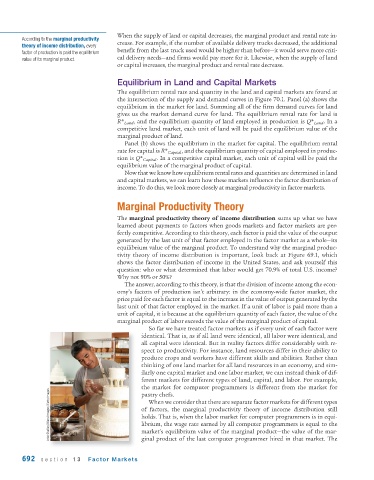Page 734 - Krugmans Economics for AP Text Book_Neat
P. 734
When the supply of land or capital decreases, the marginal product and rental rate in-
According to the marginal productivity
crease. For example, if the number of available delivery trucks decreased, the additional
theory of income distribution, every
benefit from the last truck used would be higher than before—it would serve more criti-
factor of production is paid the equilibrium
value of its marginal product. cal delivery needs—and firms would pay more for it. Likewise, when the supply of land
or capital increases, the marginal product and rental rate decrease.
Equilibrium in Land and Capital Markets
The equilibrium rental rate and quantity in the land and capital markets are found at
the intersection of the supply and demand curves in Figure 70.1. Panel (a) shows the
equilibrium in the market for land. Summing all of the firm demand curves for land
gives us the market demand curve for land. The equilibrium rental rate for land is
R* Land , and the equilibrium quantity of land employed in production is Q* Land . In a
competitive land market, each unit of land will be paid the equilibrium value of the
marginal product of land.
Panel (b) shows the equilibrium in the market for capital. The equilibrium rental
rate for capital is R* Capital , and the equilibrium quantity of capital employed in produc-
tion is Q* Capital . In a competitive capital market, each unit of capital will be paid the
equilibrium value of the marginal product of capital.
Now that we know how equilibrium rental rates and quantities are determined in land
and capital markets, we can learn how these markets influence the factor distribution of
income. To do this, we look more closely at marginal productivity in factor markets.
Marginal Productivity Theory
The marginal productivity theory of income distribution sums up what we have
learned about payments to factors when goods markets and factor markets are per-
fectly competitive. According to this theory, each factor is paid the value of the output
generated by the last unit of that factor employed in the factor market as a whole—its
equilibrium value of the marginal product. To understand why the marginal produc-
tivity theory of income distribution is important, look back at Figure 69.1, which
shows the factor distribution of income in the United States, and ask yourself this
question: who or what determined that labor would get 70.9% of total U.S. income?
Why not 90% or 50%?
The answer, according to this theory, is that the division of income among the econ-
omy’s factors of production isn’t arbitrary: in the economy-wide factor market, the
price paid for each factor is equal to the increase in the value of output generated by the
last unit of that factor employed in the market. If a unit of labor is paid more than a
unit of capital, it is because at the equilibrium quantity of each factor, the value of the
marginal product of labor exceeds the value of the marginal product of capital.
So far we have treated factor markets as if every unit of each factor were
identical. That is, as if all land were identical, all labor were identical, and
all capital were identical. But in reality factors differ considerably with re-
spect to productivity. For instance, land resources differ in their ability to
produce crops and workers have different skills and abilities. Rather than
thinking of one land market for all land resources in an economy, and sim-
ilarly one capital market and one labor market, we can instead think of dif-
ferent markets for different types of land, capital, and labor. For example,
the market for computer programmers is different from the market for
Ariel Skelley/Blend Images/Getty Images of factors, the marginal productivity theory of income distribution still
pastry chefs.
When we consider that there are separate factor markets for different types
holds. That is, when the labor market for computer programmers is in equi-
librium, the wage rate earned by all computer programmers is equal to the
market’s equilibrium value of the marginal product—the value of the mar-
692 section 13 Factor Markets ginal product of the last computer programmer hired in that market. The

